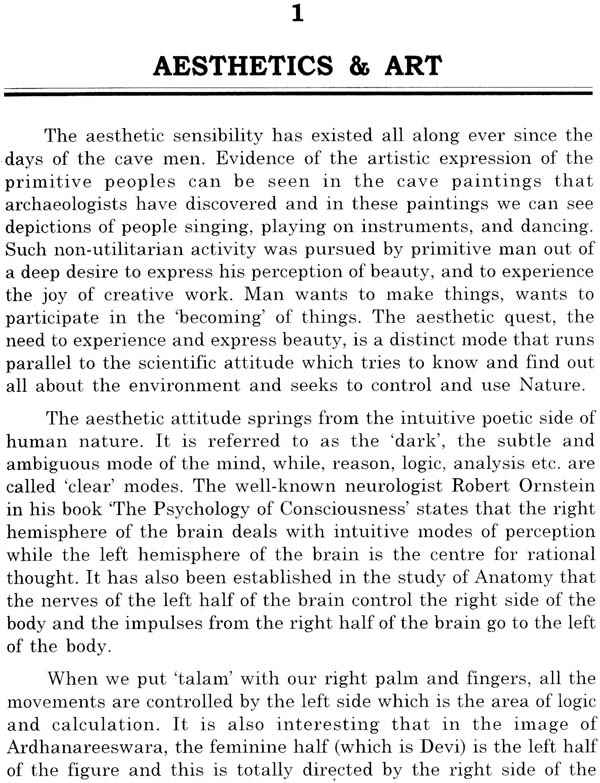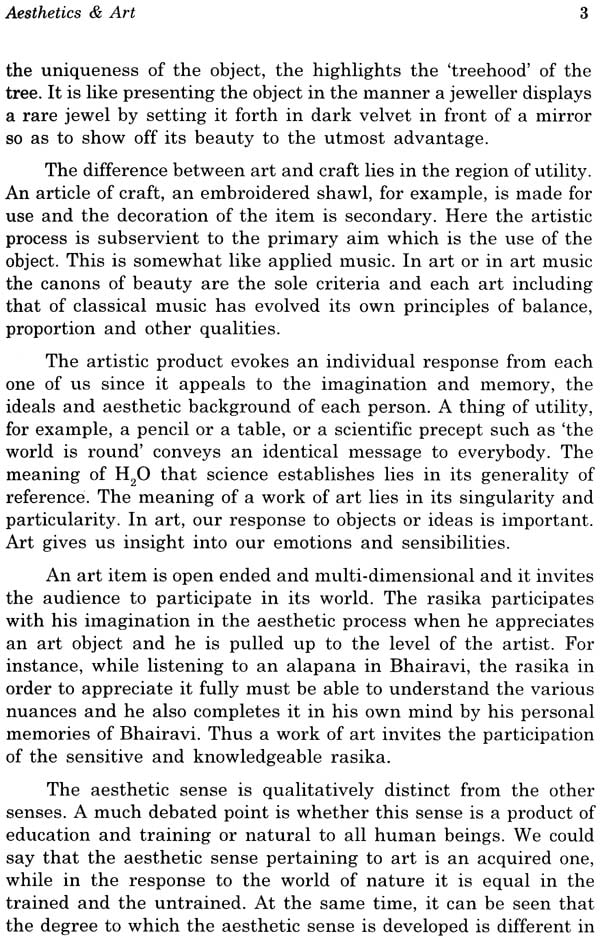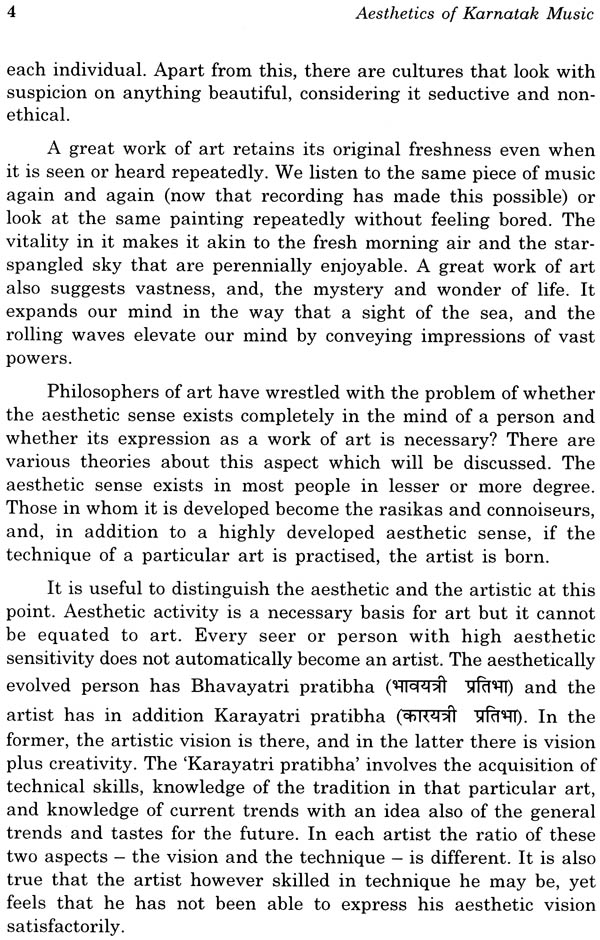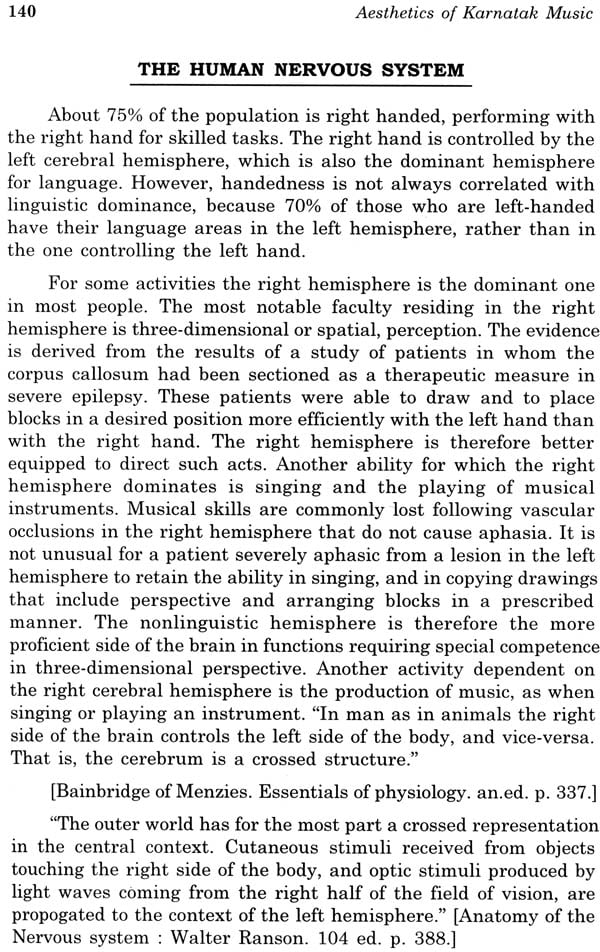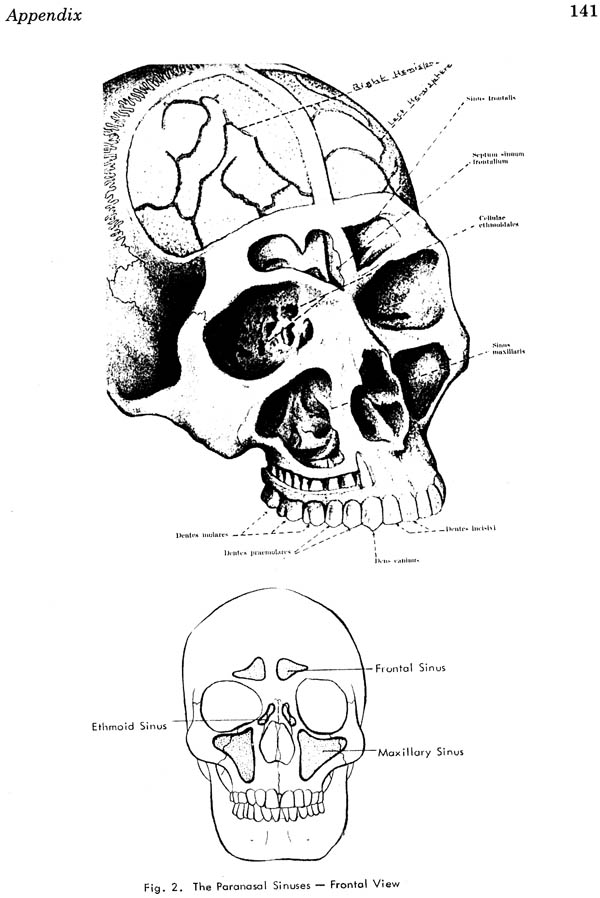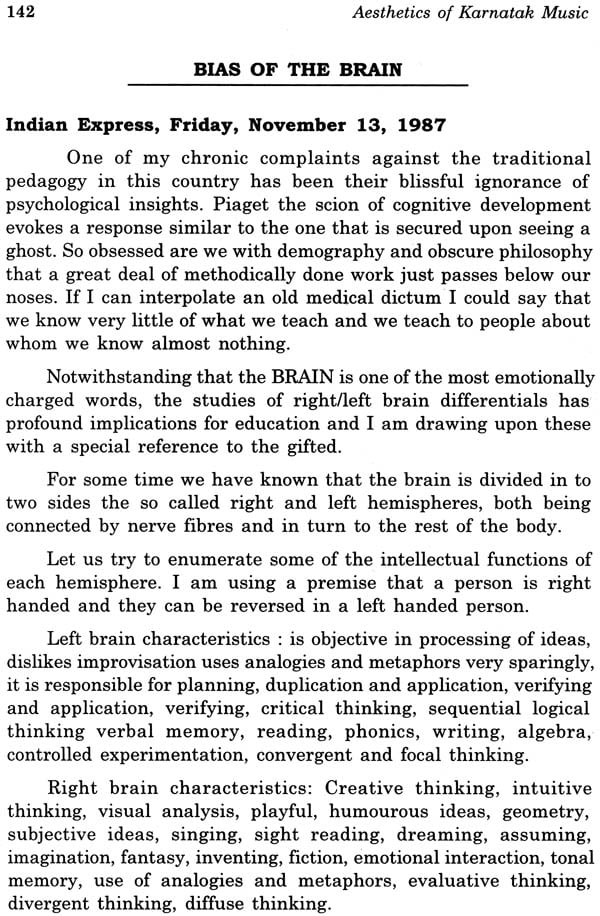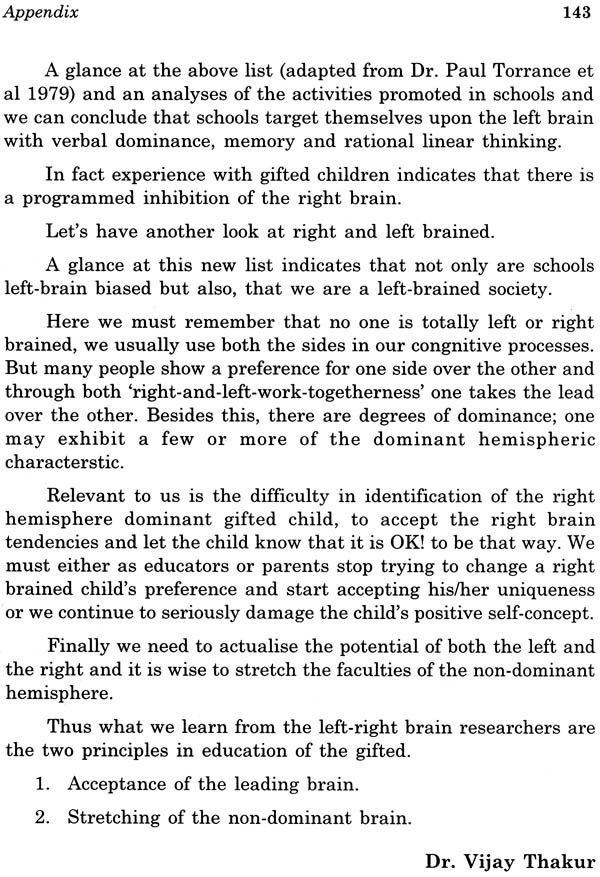
Aesthetics of Karnatak Music
Book Specification
| Item Code: | NAM221 |
| Author: | Lalita Ramakrishna |
| Publisher: | B.R. Publishing Corporation |
| Language: | English |
| Edition: | 2016 |
| ISBN: | 9788188827572 |
| Pages: | 168 (11 B/W Illustrations) |
| Cover: | Hardcover |
| Other Details | 10.0 inch X 7.0 inch |
| Weight | 420 gm |
Book Description
This book enables you to understand and appreciate Aesthetic values in Karnatak music.
It gives you an insight into the aesthetic ideals that have shaped the Classical Music of southern Indian. Karnatak Music is an ancient Art form that is vibrantly alive today in the South of the India. Both the major Forms –Hindustani and Karnatak Music –have their origin in a common artistic heritage that is over 2000 years old.
Ancient music scholars sang for self expression and link with the classical music of their past their masters. They developed the vocal and instrumental music of the their times. They were most also interested in recordings their vision of this Classical Art from.
Indian classical music is a sophisticated art form that specializes in Melody and the subtle nuances of sound, as well as in intricate permutations of Rhythm. It has explored a vast variety of nuances in sound through it gamakas. The temper of today’s listener seeker the background and context of this art.
This Book is Aesthetics analyses “the beauty “ of cure elements in Karnatak Music-such as:-Alapana, Bhavam, Sahityam, as well as Ragam-Tanam–Pallavi and Sabha gana (Concert music).
The picture at the end of this book make abstract ides in Aesthetics easy to understand. Ideas such as “silence”(visranti) in music have been illustrated with the help of Japanese painting and their use of “Empty Space”.
Karnatak music is sublime because it is meshed with the spiritual. Every word and each theme ‘become’ sublime because it expresses the Divine. Song and dance are elevated from the level of mere entertainment to the hallowed, primarily because of the sahityam in krtis.
This Book illumines seminal concepts of Indian Aesthetics the way in which these concepts are expressed in Karnatak music.
M. phil. English Lit.(Central Instituted of English, Hyderabad) and Ph.d in Karnatak Music (Delhi Univ.) is Director of Research at Tattvaloka (Chennai).
This book enables you to understand and appreciate Aesthetic Values in Karnatak Music.
It analyses "the beauty" of core elements in Karnatak Music- such as :- Alapana, Bhavan, Sahityam of kritis, Ragam - Tanam- Pallavi and Sabha gana (Concert music).
Bharata said in Natya Sashtra that all art has to be savored and relished like a tasty dish. The pictures and references in this book make the abstract ideas in Aesthetics easy to understand. Ideas such as "silence" (visranti) in music have been illustrated with the help of Japanese painting and their use of "Empty Space".
This book shows how the values of Satyam Sivam Sundaram - (the True - the Benign and the Lovely) are intrinsic in this Art form. It facilitates our enjoyment of these extra-fine values which are woven into the fabric of Indian Classical Music.
Indian classicial music is a sophisticated art form that specializes in Melody and the subtle nuances of sound, as well as in intricate permutations of Rhythm. The temper of today's listener seeks the background and context of this art, which is a vital part of Indian culture.
This Book illumines seminal concepts of Indian Aesthetics and the way in which these concepts are expressed in Karnatak music. This analysis will be of use to those who give Lecture Demonstrations on Karnatak music.
This book could not have taken shape without the encouragement and help of my husband GVR, who has involved himself in every aspect of this project.
Aesthetics is a study of 'beauty' in art and it is a study that tries to locate the exact areas which are 0 alue' and of 'significance' to a particular art form. This dissertation deals with the Aesthetics of Karnatak music and also sees it in relation to change in the cultural scene.
Change being inherent in life processes, anything as closely related to our psyche as music, has perforce to change too. Classical music, if it is to survive, has to be a living tradition that takes into its orbit the contemporary outlook on life, leisure and art. Classicism should not degenerate into rigidity or surely 'rigor mortis' will set in. At the same time, a traditional art form such as this, cannot bend to every whim or idiosyncracy of modern taste. Thus it is essential to look long and to look carefully at the aesthetic ideals of our music against the background of sociocultural factors.
The Aesthetics of Karnatak Music is a topic of great relevance to all who are interested in the art; to the maestro and the amateur, as well as, to the informed listener and the layman. This book seeks to analyse the various components of Karnatak music such as Ragam, Bhavam, Layam, Sruti, and Sahityam in order to find out the essential vital 'core' of these various facets of music. From the standpoint of a music student, a clear understanding of concepts such as 'bhavam' are of crucial importance. An understanding of each these aspects of music anables us to critically evaluate the music of the performance in today's scene. The idea of 'change', which is built into a living tradition, so that we think of tradition as a living stream, rather than as something fixed and static, has been incorporated in order to highlight this vital aspect.
The hypothesis of this book is two pronged: (i) that Karnatak music has the potential to remain classical as well as beautiful inspite of changing lifestyles and modes of thinking; (ii) that it is important to locate the underlying principles of classicism and aesthetics in this art so that the inevitable change that affects everything with the passage of time does not affect the cardinal 'core' of the genre. For instance, the time constraint in modern life demands capsule music that can be accommodated to Radio or TV programmes. In this regard if we are firm in our conviction (a) that sponteneity is essential in creative music, and (b) that it is possible to evoke 'visranti' or 'repose' even within a short time, if we do not rush the music and allow silence its place in the music, such problems in the Aesthetics of music can be tackled. If we understand that 'bhavam' in Karnatak music is not merely 'emotional' music, we will perhaps avoid copying the crooning, whispering, and other techniques that are a part of 'filmi' geet. The two main points in the hypothesis are, that, a major art form such as this, is governed by established aesthetic norms, (the restraint and subtlety of the classical tradition) as well as, by popular taste. In short, it is a look at the question of how to please the Goddess of music as well as today's audience.
We should be able to affirm present day trends and preserve the beauties of the past in a contemporary mold. Now one is either (a) belligerently modern, or (b) vaguely apologetic for playing to the gallery, or (c) quite adamantly dogmatic that all the truly classical music was in the past.
Anything beautiful is naturally and immediately attractive, so how is it that an art that is built upon beauty of tone and rhythm is losing its ground? Perhaps we have our eyes more on the rulebook of music than on its intrinsically attractive aspects like sweetness, perfect layam, clarity of diction etc. The grammar of a language always follows usage, so today's rule-book in music should be adapted to the changed features of today's Karnatak music. It is here that a proper notion of the fundamentals of music, a clear understanding as to what is ragam, bhavam, etc. comes in handy. And this is the thrust of the present work-to locate the absolutes and the ideal in this genre and also to look at the music of today and of the recent past in relation to the ideals. If we are vague about the ideals, it is quite possible, that we will be left holding on to an empty shell from which the spirit has fled. This has happened in the area of religious ritual, and, is likely to happen to classical music too, if there is blind allegiance to mere custom without applying the aesthetic norms. Classicism and beauty are the standards that are true for all time, and within this ambit, all change and modernism can be encouraged.
A look around us shows the infiltration of western culture, which is increasing in the same ratio as the speed of international communication. The world has become smaller now because of the unprecedented acceleration of communication, media coverage, and more travelling to more places by artists as well as lay people. Such cross cultural exchanges have their impact on the artist, his art, and his audience. The average Indian today is exposed to the latest developments from the west. These inputs range from trivial consumer products, to major encroachments into life styles (e.g., T.V. or Video is the preferred entertainment), to deeper concepts that influence his expectation of the arts. The layman and the learned are both affected by these inputs. The lay person absorbs all the influences in an indiscriminate fashion and perhaps follows the path of least resistance. The urban youngster falls into the easy snare of pop music and very few 'dare' to think differently or 'dare' to act differently.
Today's classical musician is faced with an audience that is ecletic, and it tends to judge the music presented by the yardstick of other music to which it is exposed, like film songs, pop songs, light music, T.V. 'Ad' music etc. The universally pleasing qualities of music have to be there to hold today's audience. The younger generation today has an 'international' outlook and they are not prepared to accept anything just because it is old or just because it is part of our culture. A questioning attitude and easy essimilation of other cultures is the way of life. Keeping this in mind, a study of Aesthetic theories of western culture has been made.
This study in the Aesthetics of Karnatak music is seen with reference to socio-cultural changes that have occured recently. We do not have any recorded avidence of the classical music before the present century and we can only infer this from the anecdotes about the length of the performances and the competitions and other descriptions. We have more reliable evidence of the music of the 20th C. The term 'change' thus refers to the present century.
Particular styles like that of Madurai Mani's or G.N.B.'s are not discussed because this book is on the conceptual level. The idea is to define, analyse and locate the scope of each aspect of music. What is a Raga? What it its place in this art as compared to other aspects such as talam or sahityam? Can it preserve its identity and vitality in todays world? Such will be the preoccupations while writing this book.
The reason for the choice of this topic are manifold. It is an affort to :
(a) Locate plus and minus points in this art from the standpoint of aesthetic appeal. All aspects are thus looked at from the point of Aesthetics exclusively.
(b) To shed some light on notions like 'Soukhyam', 'Bhavam', 'Weight', 'Classical weight' for instance, is commonly associated with a rugged voice technique.
(c) To see what aspects are pleasing in other forms of music and even in some other arts like painting and dance, and whether some ideas from these can be incorporated into our musical system.
(d) To see if classical music can lend itself to simpler forms also-like nursery rhymes for children, signature tunes, background music in films and shows, social and secular songs for teenage get-togethers and common festivals. We must remember that originally, the Gandharvan, from which this system has originated, was developed purely for entertainment of the masses. The idea is to find out whether by holding on to a core of classicism, the raga, talam and lyric can be adopted to fulfill this lacuna in today's scene. 'Classical' as entertainment is almost nil and this vacuum is being filled up by Jack and Jill rhymes, by pop music for the teens, and film music for most functions. This does not mean that the classical genre loses its place as an art that is evocative of the most profound transcendental states. Only whether in addition to this hallowed function, it can also be adopted for wholesome entertainment.
(e) To see whether specialisation in various different forms such as javalis, padams, pallavi etc. will enrich the musical scene.
(f) To see whether sabha gana can educate its audience and create good taste or whether it will have to cater to the common tastes.
This book looks mainly at the concepts. Practical suggestions like "how to imporve the voice and tone" or "what kind of auditorium and mike arrangement", and so on, will not be dealt with in detail. The Aesthetics of Instrumental music will also be left out as this is a vast subject in its own right. The pakka vadyam in a concert will be discussed briefly in the chapter on Sabha Gana.
The topic 'Aesthetics' is in the field of philosophy and in applying Aesthetical criteria to music, the talam, strui and other aspects are dealt with as concepts rather than in their practical applied forms. For instance, in an analysis of Raga the practical approach will entail elaboration of the vadi-samvadi aspects, the amsa swara and other raga lakshanas. Such studies are already there in profusion. It is an accepted idea that the raga is more than the sum of its scale, gamakams and other 'Iakshanas'. The abstract form of the raga, with which we are concerned at a higher level of music, has an elusive quality. Likewise other aspects like layam, tone, etc. are not easily definable. To understand these, the analogical method will be used. These abstract notions will be described with the help of analogies and similes. In order to get a picture of the general attitude prevalent among the vidwans and the rasikas, the survey method will be employed. A questionnaire dealing with aspects of performance in the scene today will be sent to artists and rasikas and as far as possible they will be personally interviewed in order to get the know their feelings about the aesthetics of music. The approach in this book will be one of analysis and definition of concepts and also an assessment of the views of the cognoscenti. It is thus a combination of abstract conceptual analysis and a gathering of factual data from performers and musicologists and critics and intelligent rasikas.
The methodology will include reading up of the major concepts in Indian and Western Aesthetics and relating them to our system of music. So far, an Aesthetic theory specifically for music has not been developed. Indian Aesthetics has dealt, in the past, with drama and poetics (Alenkara Sastra), so only those ideas relevant to music will be taken from the ancient texts. Western Aesthetics is a branch of philosophy and deals with the 'subject object' relation in Arts and life. Here again only theories relevant to our music will be discussed.
A study of Indian social and cultural history is important for this topic. There is no historical study done exlusively on the musicocultural life of our ancestors. Material will be collected from books on general Indian history and also inference will be drawn from treatises on music like the Sangita Samaya Sara. A look at the music reviews in the weekly edition of the Hindu, Economic Times and other papers will give a very good idea of Aesthetic concepts and expectations, of the manner in which an artist's performance is graded. Listening to the music of the past masters from private collections and from the archives in the Sangita Natak Academy and talking to the older generation in order to get first hand information about their reactions to the music of the past and the present is helpful for this subject. Although music is an organic unit, it is useful to take it apart and see the various aspects individually. Just as we are more precise when we say that a particular flower "has a lovely colour but no fragrance," instead of just saying that "it is beautiful"; we should be able to anlayse a performance and make a statement such as "the Bhairavi raga elaboration was skillful but it lacked bhavam".
| Preface | (iii) | |
| Introduction | (vii) | |
| 1 | Aesthetics & Art | 1 |
| 2 | Aesthetic Theories: Indian & Western | 11 |
| 3 | The Socio-Cultural Ethos | 24 |
| 4 | Raga & Alapana | 38 |
| 5 | What Exactly is Bhavam? | 50 |
| 6 | Sruti, Tone & Voice Culture | 60 |
| 7 | Layam & Talam | 75 |
| 8 | Sahityam - The Lyrical Language | 87 |
| 9 | The Tough Allure of the Pallavi | 97 |
| 10 | Whither Sabha Gana? | 106 |
| 11 | Today's Perspectives - A Field Study | 116 |
| 12 | Denouement | 129 |
| Appendix | 134 | |
| Japanese Sumiye Painting. Modern Scultpure Sinus Cavities in the Skull. Right & Left Hemispheres of the Brain and their Functions. Physiology of Voice Production | ||
| Bibliography | 148 | |
| Abbreviations | 152 |
